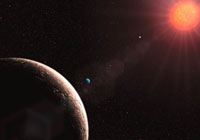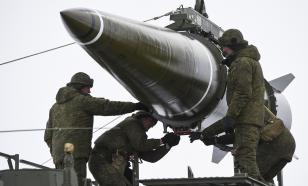Smallest Exoplanet Known to Man Looks Exactly Like Earth
It has been long considered that nearly all planets in the Universe are gas giants. However, the latest research of the depths of space showed that this theory is rather doubtful. Astronauts often discover exoplanets that get closer and closer to the parameters of Earth. Pravda.ru talked about the discovery of one of these planets with Nikolai Potashev, an employee of The Sternberg Astronomical Institute.

A small unremarkable planet that doesn’t even have a name, just a number - TYC 4799-1733-1 - surprised astronauts. It turned out to be the smallest of all exoplanets known to this day. Although the “small” size is rather relative, it once again proves that celestial bodies similar to Earth are spread out around the entire Universe.
Now the celestial body located in the constellation of Monoceros, 500 light years from the Sun, is honored with a short name CoRoT-7 and together with its orbital body received the attention of the astronomic community.
The diameter of CoRoT-7b exoplanets is 80 percent larger than the diameter of Earth, and its mass exceeds the mass of Earth by five times. Simple calculations show that both planetoids have the same crust density, which means that many geophysical characteristics are the same.
CoRoT-7b rotates the entire circle around its host star within 20.4 hours, which is confirmed by periodical eclipses observed from Earth. The distance between the planet and its host star is only 2.5 million kilometers, 23 times less than the distance between Mercury and the Sun.
The speed of CoRoT-7b orbital motion is 750,000 kilometers an hour, seven times faster than the speed of the corresponding Earth parameter. The high speed of rotation and proximity to its host star makes the discovered exoplanet uninhabitable as the temperature of the dayside of CoRoT-7b is 2000C, and the shady side – negative 200C.
However, several other parameters are very similar to the parameters of Earth, which makes the planet an excellent study object. The discovery of the planet is another proof of existence of numerous types of planetoids in the Universe. This means that the chances of discovering a celestial body similar to Earth and suitable for life we are used to are great.
A neighboring planet rotating around the same host star CoRoT-7 also attracted the attention of astronauts. Planetoid CoRoT-7c is eight times heavier than Earth and it takes it three days and 17 hours to rotate full circle around its host star. During the observation this exoplanet never crossed the line between its star and the Sun, which makes it impossible for the scientists to calculate its approximate size.
Pravda.ru asked Nikolai Potashev, an employee of The Sternberg Astronomical Institute, to comment on the new discoveries.
“Exoplanet CoRoT-7b is, in fact, the first planetoid that we can firmly say has a solid rocky body, like Earth and Mars. All previous discoveries were either gas giants, or heterogeneous bodies that contained large amounts of ice. Besides, due to various reasons, we were unable to calculate the density of many planets.
The discovery of CoRoT-7b and -7c along with other interesting astronomic discoveries of the last years suggests that our astronomical knowledge grows every year in geometrical progression. We cannot rule out the possibility of finding an exoplanet in the next two to three years that will be similar to Earth in all parameters – mass, size, distance to its host star, and rotation speed.”
Pavel Urushev
Pravda.Ru
Subscribe to Pravda.Ru Telegram channel, Facebook, RSS!


